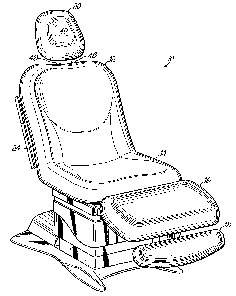Some of the information on this Web page has been provided by external sources. The Government of Canada is not responsible for the accuracy, reliability or currency of the information supplied by external sources. Users wishing to rely upon this information should consult directly with the source of the information. Content provided by external sources is not subject to official languages, privacy and accessibility requirements.
Any discrepancies in the text and image of the Claims and Abstract are due to differing posting times. Text of the Claims and Abstract are posted:
| (12) Patent: | (11) CA 2639567 |
|---|---|
| (54) English Title: | FLOATING BEARING AND CLAMP SYSTEM FOR PATIENT PROCEDURES CHAIR MOUNTING AND POSITIONING POSTS |
| (54) French Title: | SYSTEME FLOTTANT DE BRIDE ET DE PORTEE POUR LE MONTAGE DE FAUTEUILS MEDICAUX ET POTEAUX DE POSITIONNEMENT |
| Status: | Granted and Issued |
| (51) International Patent Classification (IPC): |
|
|---|---|
| (72) Inventors : |
|
| (73) Owners : |
|
| (71) Applicants : |
|
| (74) Agent: | MACRAE & CO. |
| (74) Associate agent: | |
| (45) Issued: | 2015-11-03 |
| (22) Filed Date: | 2008-09-12 |
| (41) Open to Public Inspection: | 2009-03-20 |
| Examination requested: | 2013-08-19 |
| Availability of licence: | N/A |
| Dedicated to the Public: | N/A |
| (25) Language of filing: | English |
| Patent Cooperation Treaty (PCT): | No |
|---|
| (30) Application Priority Data: | ||||||
|---|---|---|---|---|---|---|
|
The headrest and side rails of a patient procedures chair are mounted on posts which are slidably received in elongated, self-aligning or floating plastic bearings. With this construction, any misalignment of the posts due to manufacturing tolerances will be accounted for as the bearings readjust themselves. Clamping devices engage the bearings and cause deformation to increase the frictional engagement of the bearings with the posts to the point where the posts are locked into place. In this regard, actuation of the clamps is accomplished by large knobs that protrude from the back of the chair for ready accessibility.
Lappuie-tête et les rails latéraux dune chaise prévue pour un patient sont fixés sur des montants accueillis de façon coulissante dans des coussinets de plastique allongés, à autocentrage ou flottants. Vu cette construction, tout mauvais alignement des montants attribuable à des tolérances de fabrication sera pris en compte étant donné que les coussinets flottants sajustent. Des dispositifs de retenue entraînent les coussinets et font en sorte que la déformation augmente la friction des coussinets avec les montants, au point où les montants sont verrouillés en place. Ainsi, lactivation des éléments de retenue se fait par de larges poignées qui font saillie du derrière de la chaise, pour une accessibilité rapide.
Note: Claims are shown in the official language in which they were submitted.
Note: Descriptions are shown in the official language in which they were submitted.

2024-08-01:As part of the Next Generation Patents (NGP) transition, the Canadian Patents Database (CPD) now contains a more detailed Event History, which replicates the Event Log of our new back-office solution.
Please note that "Inactive:" events refers to events no longer in use in our new back-office solution.
For a clearer understanding of the status of the application/patent presented on this page, the site Disclaimer , as well as the definitions for Patent , Event History , Maintenance Fee and Payment History should be consulted.
| Description | Date |
|---|---|
| Common Representative Appointed | 2019-10-30 |
| Common Representative Appointed | 2019-10-30 |
| Grant by Issuance | 2015-11-03 |
| Inactive: Cover page published | 2015-11-02 |
| Inactive: Final fee received | 2015-06-29 |
| Pre-grant | 2015-06-29 |
| Notice of Allowance is Issued | 2015-01-14 |
| Letter Sent | 2015-01-14 |
| Notice of Allowance is Issued | 2015-01-14 |
| Inactive: Q2 passed | 2014-12-31 |
| Inactive: Approved for allowance (AFA) | 2014-12-31 |
| Amendment Received - Voluntary Amendment | 2014-12-09 |
| Inactive: S.30(2) Rules - Examiner requisition | 2014-06-12 |
| Inactive: Report - No QC | 2014-06-05 |
| Letter Sent | 2013-08-29 |
| Amendment Received - Voluntary Amendment | 2013-08-19 |
| Request for Examination Requirements Determined Compliant | 2013-08-19 |
| All Requirements for Examination Determined Compliant | 2013-08-19 |
| Request for Examination Received | 2013-08-19 |
| Application Published (Open to Public Inspection) | 2009-03-20 |
| Inactive: Cover page published | 2009-03-19 |
| Inactive: First IPC assigned | 2009-03-09 |
| Inactive: IPC assigned | 2009-03-09 |
| Inactive: Filing certificate - No RFE (English) | 2008-10-21 |
| Application Received - Regular National | 2008-10-21 |
There is no abandonment history.
The last payment was received on 2015-08-21
Note : If the full payment has not been received on or before the date indicated, a further fee may be required which may be one of the following
Patent fees are adjusted on the 1st of January every year. The amounts above are the current amounts if received by December 31 of the current year.
Please refer to the CIPO
Patent Fees
web page to see all current fee amounts.
Note: Records showing the ownership history in alphabetical order.
| Current Owners on Record |
|---|
| MIDMARK CORPORATION |
| Past Owners on Record |
|---|
| MARK G. DILLER |